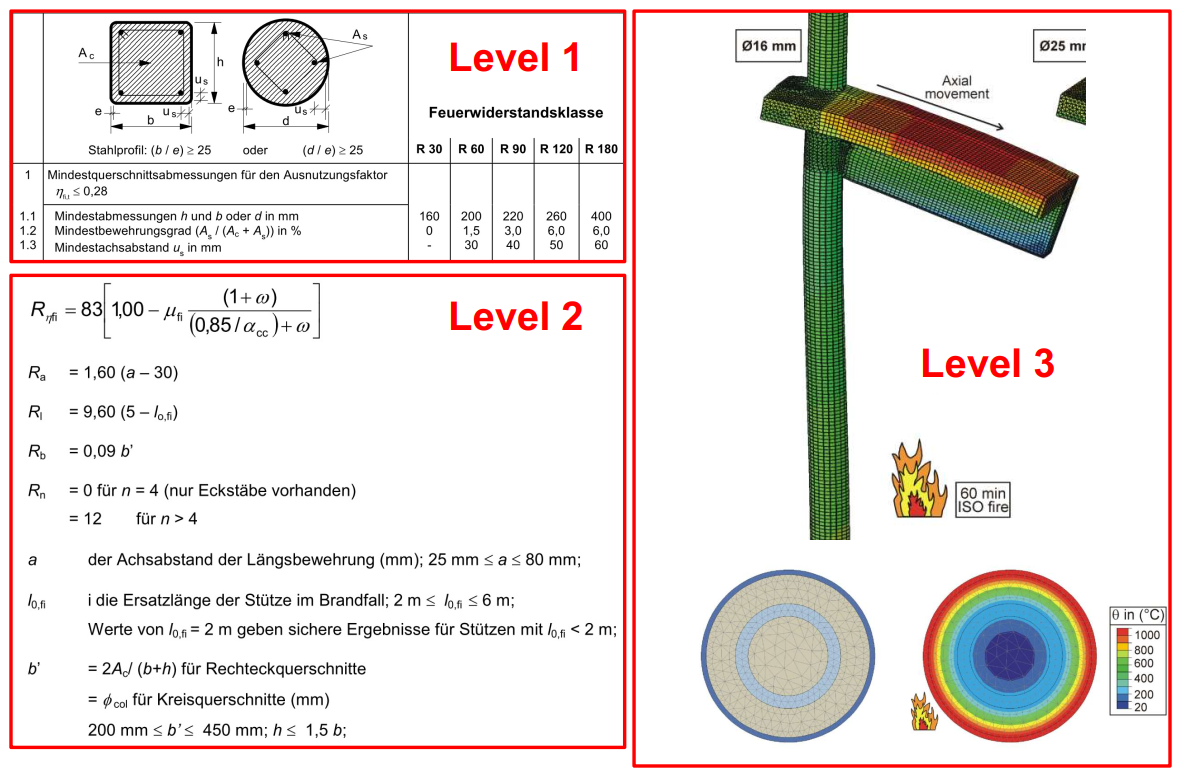Fire design according to Eurocodes
Which Eurocodes are important for the fire safety design?
Before the introduction of the Eurocodes in Germany by building authorities, DIN 4102-22, which has meanwhile been withdrawn, applied to the dimensioning of building components in Germany. The fire protection design for components was carried out with the help of simplified design tables. These tables prescribe for example for a reinforced concrete column minimum cross-sectional dimensions, deepending on its load ratio and the required fire resistance period.
Since 2012 the Eurocodes have to be applied. For each construction there is a fire protection part that ends with the designation "-1-2". These parts are also called "hot Eurocodes" in technical jargon. The fire protection-related Eurocodes for the most important construction methods are listed below as examples:
- EN 1991-1-2: Eurocode 1: General actions - Actions on structures exposed to fire;
- EN 1992-1-2: Eurocode 2: Design of concrete structures - Part 1-2: General rules - Structural fire design;
- EN 1993-1-2: Eurocode 3: Design of steel structures - Part 1-2: General rules - Structural fire design;
- EN 1994-1-2: Eurocode 4: Design of composite steel and concrete structures - Part 1-2: General rules - Structural fire design;
- EN 1995-1-2: Eurocode 5: Design of timber structures - Part 1-2: General - Structural fire design.
In addition to the various verification methods (level 1 to 3, see the following section), constructive details for the various construction methods are also regulated in the hot Eurocodes.
How is the fire design carried out according to the Eurocode?
Design methods (level 1 to 3)
As can be seen in the picture below, the hot Eurocodes have different levels of verification (level) 1 to 3. The verifications at level 1 are the easiest and fastest to do, while level 2 and especially level 3 require significantly more effort require. On the other hand, Level 3 (fire design), in particular, often results in significantly more economical constructions than using a Level 1 method.

Simplified design tables (level 1 method)
Similar to the then national standard DIN 4102-22, the hot Eurocodes for the hot design of columns and beams provide simplified design tables for common cross-section types. These are each based on the ISO standard fire. In order to be able to use the dimensioning tables, the following input parameters are required:
- Load utilization of the fire-exposed member;
- buckling length in case of fire.
Depending on the fire resistance period to be achieved and the respective load utilization, the requirements for the cross-section can be read from the design tables, such as the required cross-section dimensions for reinforced concrete columns, as well as the minimum reinforcement for the event of fire and the associated concrete cover.
For steel structures there are no such design tables in EN 1993-1-2. Due to the high thermal conductivity of steel, steel constructions cannot usually be divided into a fire resistance class because they fail before. However, if fire protection cladding of sufficient thickness is arranged, steel constructions easily achieve high fire resistance durations. The required thickness can either be determined using a simplified design method (level 2 method) in EN 1993-1-2 or looked up in the relevant product catalogs for fire protection cladding, e.g. at Isover or Promat.
Simplified design methods (level 2 method)
In addition to the design tables, some simplified design methods are described in the Eurocodes, e.g. Method A for the design of reinforced concrete columns exposed to fire. With the help of these methods, more economical solutions can often be found than with the design tables, because the input parameters are more precise and extensive (e.g. the exact concrete cover). In this respect, the greater engineering effort is rewarded by increased cost-effectiveness.
General calculation methods (level 3 method)
Where there is a level 2 procedure, a level 3 procedure must not be missing. This means the proof of members and constructions, mostly based on finite element software. This procedure is called fire design in technical jargon. The level 3 method requires the most effort, but usually results in the most economical solution. However, these methods are usually only common in engineering firms dedicated to structural fire protection. So if you should face such a challenge, do not hesitate to contact me. I will then be happy to help you find an attractive solution for you.
How I can help you.
I offer you a short-term fire design. The documentation contains the essential information on the heating of the cross-section, the fire resistance period of the member and its deformations. Other services can of course be provided in consultation with you.
What are your benefits?
The fire design often saves the client costs. In the case of new buildings, slimmer and therefore more economical constructions can be implemented. When building in existing buildings, extensive upgrading measures can often be avoided through precise calculations.
When should you contact me?
In the case of new properties to be built, it is highly recommended that you involve me in the planning phase. In the case of unprotected steel structures in particular, the hot design is often decisive for the choice of profile.
My initial consultation for your project
In order to clarify your specific task, it is best to give me a call. Or you can send me an e-mail with a few key data. Floor plans, views and sections of the respective building project are helpful, which I will of course treat confidentially. On this basis we can discuss the general conditions and I can make you an attractive offer.